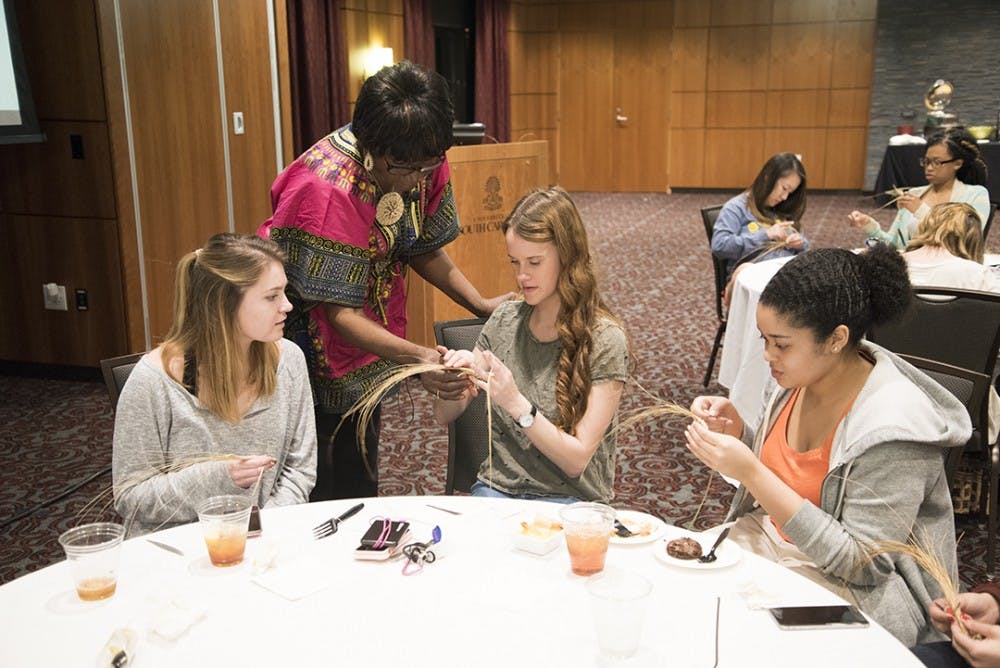For the second year in a row, the Office of Multicultural Student Affairs hosted “Sweetgrass Basket Weaving with Sarah Hammond.” The event was held in the Capstone Campus Room and involved a basket-weaving workshop and a buffet-style spread of Lowcountry-inspired cuisine including shrimp and grits, collard greens and barbecue chicken.
Sarah Hammond is a basket maker from Mount Pleasant, South Carolina, and a South Carolina Arts Commission approved artist. Hammond opened up the event with a brief introduction and history of sweetgrass baskets before launching into the class and assisting the participants. Attendees were instructed on how to weave their own sweetgrass placemat. Hammond and her daughter were instrumental in showing participants how to use a specially designed tool called a “nailbone,” coil the sweetgrass and secure the coils with palm leaves.
The tradition of weaving coiled grass baskets can be traced back to Western African countries like Sierra Leone, where tribes such as the Mende and Temne made baskets similar to the ones seen today. When West Africans were brought to the southeastern United States in the 17th century as part of the transatlantic slave trade, they brought their basket weaving traditions with them.
The West African slaves, already acclimated to a humid climate, were critical to the production of profitable rice crops in the South. They were able to create baskets to help separate rice hulls from the chaff and to store shellfish, grain, vegetables and cotton. These agricultural vessels were made mainly of a tough marsh grass called bulrush. By the early 1900s, weavers began to incorporate additional materials like pine needles, palmetto fronds and fragrant sweetgrass into their baskets. This new diversity of materials allowed weavers to express their creativity through more intricate designs and patterns.
Descendants of the original West African slaves have maintained this rich cultural tradition of sweetgrass basket weaving in the Charleston and Mount Pleasant communities for over 300 years. These craftspeople continue to pass on the skill from generation to generation.
Sarah Hammond can attest to this tradition, as basket weaving has been passed down through five generations of her family.
Hammond learned the craft from her mother at the age of seven. She described how watching elders produce and sell their crafts piqued her interest.
“I used to like hanging around the older folks and as they go out, the daily routine of putting the baskets out and sitting at the stand,” she said. “That was what I was interested in doing, and that’s how I got started.”
Hammond spent 31 years working as an office manager in the South Carolina public school system before retiring and devoting her time to basket weaving. Now she travels the country sharing her culture and teaching others how to make sweetgrass baskets. She says that she enjoys her work and that it has had a significant impact on her life. Her favorite part of her work is when her students complete their projects.
“The excitement is at the end when they have a little finished product, no matter how small, they are so excited,” Hammond said. “That’s the thrill for me is at the end.”
For some students in attendance, a desire to learn more about the familiar baskets drove them to seek this unique experience.
“I went to Charleston a few times, and I always saw these being sold on the corner and I wanted to see how they were made,” said first-year biology student Savannah Bradley.
Other students felt a personal connection to the region the baskets originate from. Fourth-year electrical engineering student Briana Luckey said she visited Charleston often because her mother grew up there.
“We would always see they people making their baskets and selling them on the streets," she said." I feel like it’s especially historical for the state, so it would be cool to take part in it.”
“Sweetgrass Basket Weaving with Sarah Hammond” presented members of the Carolina community a special opportunity to immerse themselves in Lowcountry culture through food, fellowship and craft. Participants were able to not only learn something new, but also go home with a handmade token of their hard work.
Hammond summed up the significance of the event for people who hail from South Carolina or even just spend some time here.
“It is very important, I think, for every South Carolinian to at least know how," she said. "At least to say that ‘I have tried it’ and just to have a little piece and say ‘I did this,’ so it’s very important.”

